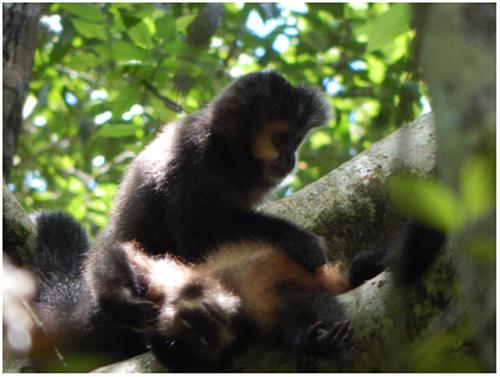当前位置:
X-MOL 学术
›
Am. J. Primatol.
›
论文详情
Our official English website, www.x-mol.net, welcomes your feedback! (Note: you will need to create a separate account there.)
Grooming site preferences in black capuchin monkeys: Hygienic vs. social functions revisited
American Journal of Primatology ( IF 2.4 ) Pub Date : 2021-10-06 , DOI: 10.1002/ajp.23336 Romina Pfoh 1, 2 , Barbara Tiddi 3, 4 , Mario S Di Bitetti 1, 2, 5 , Ilaria Agostini 1, 2, 6
American Journal of Primatology ( IF 2.4 ) Pub Date : 2021-10-06 , DOI: 10.1002/ajp.23336 Romina Pfoh 1, 2 , Barbara Tiddi 3, 4 , Mario S Di Bitetti 1, 2, 5 , Ilaria Agostini 1, 2, 6
Affiliation

|
When primates groom each other, they tend to concentrate on those parts of the body they cannot efficiently self-groom (i.e., not visually accessible), and prefer to intensify grooming in areas with high hair density, thus suggesting a hygienic function. However, preferences for some body sites over others during social grooming may also result from different degrees of social bonding and relative dominance. To assess the relative importance of physical (hygienic) and social factors, we examined grooming interactions in two groups of wild black capuchin monkeys (Sapajus nigritus) during 15 nonconsecutive months. We evaluated the distribution of social grooming across body sites according to their accessibility by self-grooming and hair density. At the same time, we assessed whether the degree of dyadic social bonding affects the relative body orientation between groomer and groomee and the access to vulnerable body sites (e.g., face, throat, groin) during grooming. As expected, capuchins preferentially groomed inaccessible body sites (e.g., back and head), with a disproportionate effort directed to the tufts of their partners. We found that dyadic social bond strength, together with rank distance, significantly affected the proportion of grooming in ventro-ventral body relative orientation only in dominant-subordinate groomer-groomee dyads. This may indicate that, when two individuals differ in rank but are strongly bonded, the level of uncertainty related to the social context is already resolved and thus grooming per se is no longer perceived by the subordinate as an uncertain/risky situation. We found no effect of social bonding on grooming vulnerable body sites for any type of dyad. Our findings suggest that grooming site preferences in black capuchin monkeys simultaneously reflect hygienic and social functions.
中文翻译:

黑卷尾猴的美容场所偏好:重新审视卫生与社会功能
当灵长类动物互相梳理毛发时,它们往往会专注于无法有效自我梳理的身体部位(即视觉上无法触及的部位),并且更喜欢在毛发密度高的区域加强梳理,从而暗示了卫生功能。然而,在社交修饰过程中对某些身体部位的偏好也可能是由于不同程度的社会联系和相对优势。为了评估身体(卫生)和社会因素的相对重要性,我们检查了两组野生黑卷尾猴(Sapajus nigritus) 在不连续的 15 个月内。我们根据自我修饰和头发密度的可及性评估了社交修饰在身体部位的分布。同时,我们评估了二元社会联系的程度是否会影响美容师和被美容师之间的相对身体方向以及在梳理过程中接触易受伤害的身体部位(例如,面部、喉咙、腹股沟)。正如预期的那样,卷尾猴优先修饰难以接近的身体部位(例如,背部和头部),并针对其伴侣的簇绒进行不成比例的努力。我们发现二元社会纽带强度以及等级距离仅在显性-从属美容师-新郎二人组中显着影响腹-腹体相对方向的梳理比例。这可能表明,当两个人等级不同但联系紧密时,与社会背景相关的不确定性水平已经得到解决,因此下属不再将修饰本身视为不确定/危险的情况。我们发现社交联系对修饰任何类型的易受伤害的身体部位没有影响。我们的研究结果表明,黑卷尾猴的梳理部位偏好同时反映了卫生和社会功能。
更新日期:2021-11-29
中文翻译:

黑卷尾猴的美容场所偏好:重新审视卫生与社会功能
当灵长类动物互相梳理毛发时,它们往往会专注于无法有效自我梳理的身体部位(即视觉上无法触及的部位),并且更喜欢在毛发密度高的区域加强梳理,从而暗示了卫生功能。然而,在社交修饰过程中对某些身体部位的偏好也可能是由于不同程度的社会联系和相对优势。为了评估身体(卫生)和社会因素的相对重要性,我们检查了两组野生黑卷尾猴(Sapajus nigritus) 在不连续的 15 个月内。我们根据自我修饰和头发密度的可及性评估了社交修饰在身体部位的分布。同时,我们评估了二元社会联系的程度是否会影响美容师和被美容师之间的相对身体方向以及在梳理过程中接触易受伤害的身体部位(例如,面部、喉咙、腹股沟)。正如预期的那样,卷尾猴优先修饰难以接近的身体部位(例如,背部和头部),并针对其伴侣的簇绒进行不成比例的努力。我们发现二元社会纽带强度以及等级距离仅在显性-从属美容师-新郎二人组中显着影响腹-腹体相对方向的梳理比例。这可能表明,当两个人等级不同但联系紧密时,与社会背景相关的不确定性水平已经得到解决,因此下属不再将修饰本身视为不确定/危险的情况。我们发现社交联系对修饰任何类型的易受伤害的身体部位没有影响。我们的研究结果表明,黑卷尾猴的梳理部位偏好同时反映了卫生和社会功能。



























 京公网安备 11010802027423号
京公网安备 11010802027423号